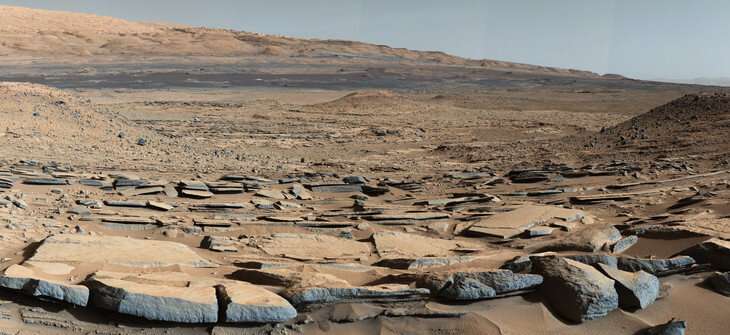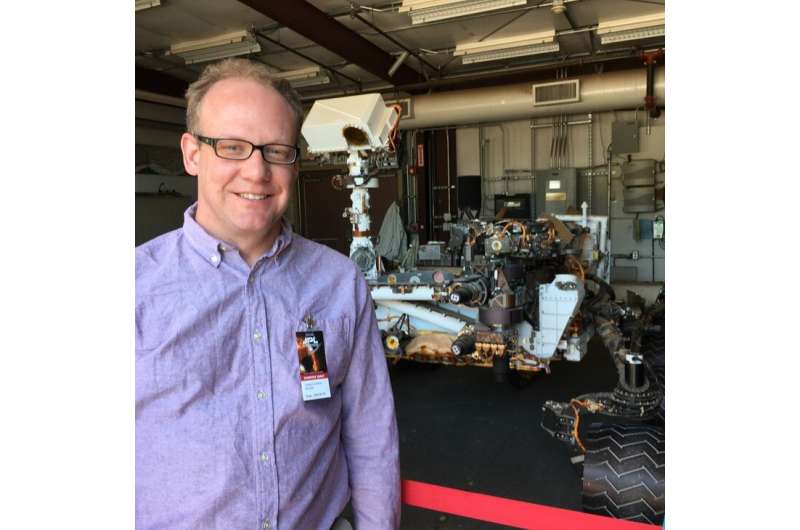Researcher sees potential for ancient life on Martian surface

Photos taken by the Mars Curiosity rover may show a desolate rocky landscape to some, but to Penn State researcher Christopher House, the photos show potential for ancient life.
Professor of geosciences and director of the NASA Pennsylvania Space Grant Consortium, House is a participating scientist with NASA's Mars Science Laboratory mission tasked with determining whether the red planet's Gale Crater could have supported life 3.5 billion years ago. According to the scientist, the research suggests that it could have.
"Gale Crater appears to have been a lake environment," House said, adding that the mission has found a lot of finely layered mudstone in the crater. "The water would have persisted for a million years or more."
The lake eventually filled with sediment and turned to stone, which then eroded, House said. The same process happened to the sand dunes that came after the lake.
"But the whole system, including the groundwater that ran through it, lasted much longer, perhaps even a billion or more years," he said. "There are fractures filled with sulfate, which indicates that water ran through these rocks much later, after the planet was no longer forming lakes."
House works with the Mars Science Laboratory's Sample Analysis at Mars (SAM) and sedimentology and stratigraphy teams. The SAM team uses an instrument that heats up rock samples and a mass spectrometer to measure molecules released by the heated samples. The mass of the molecules helps the researchers identify the types of gases released.

House and Penn State graduate student Gregory Wong are particularly interested in sulfur gases from sulfate and sulfide minerals because the presence of reduced sulfur minerals, like pyrite, would indicate that the environment could have supported life in the past.
House serves as a lead for the sedimentology and stratigraphy team, which studies the rock layers on the Martian surface to interpret the environment in which they formed. He is also involved in the rover's tactical planning. As a science theme lead, a few times per month he directs the daily teleconference held with scientists from around the globe to plan the rover's operations for the next Martian day.
"It's been fun to be involved in the daily operations, decisions like where to take a measurement, or where to drive, or whether we should prioritize a particular measurement over a different measurement given the limited amount of time on the surface," House said. "Each day is limited by the power that the rover has and how much power the rover will need. It has been a great learning experience for how missions operate and a great opportunity to collaborate with scientists from around the world."
House finds the pace at which the mission operates exhilarating and sometimes bewildering.
"Each time we drive, we wake up to an entirely new field of view with new rocks and new questions to ask," he said. "It's sort of a whole new world each time you move, and so often you're still thinking about the questions that were happening months ago, but you have to deal with the fact that there's a whole new landscape, and you have to do the science of that day as well."

This is the golden age of planetary science, according to House, who credits the Mars Science Laboratory for the push to explore and send astronauts to the red planet.
"Missions like this have shown habitable environments on Mars in the past," House said. "Missions have also shown Mars to continue to be an active world with potentially methane releases and geology, including volcanic eruptions, in the not too distant past. There's definitely great interest in Mars as a dynamic terrestrial world that is not so different than our Earth as some other worlds in our solar system."
House's work with NASA and the agency's exobiology program, which focuses on the search for life and origin of life, has led to several recent breakthroughs. These include identifying cyanide compounds in meteorites and complex chemical mixtures that could have led to the origin of life on Earth.
Provided by Pennsylvania State University





















